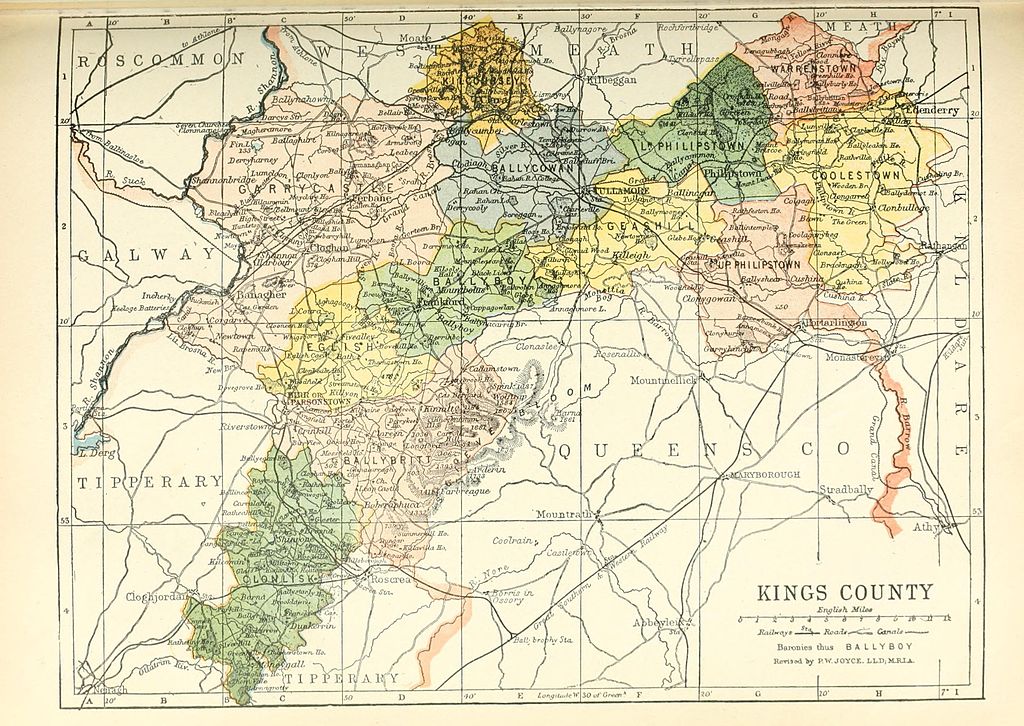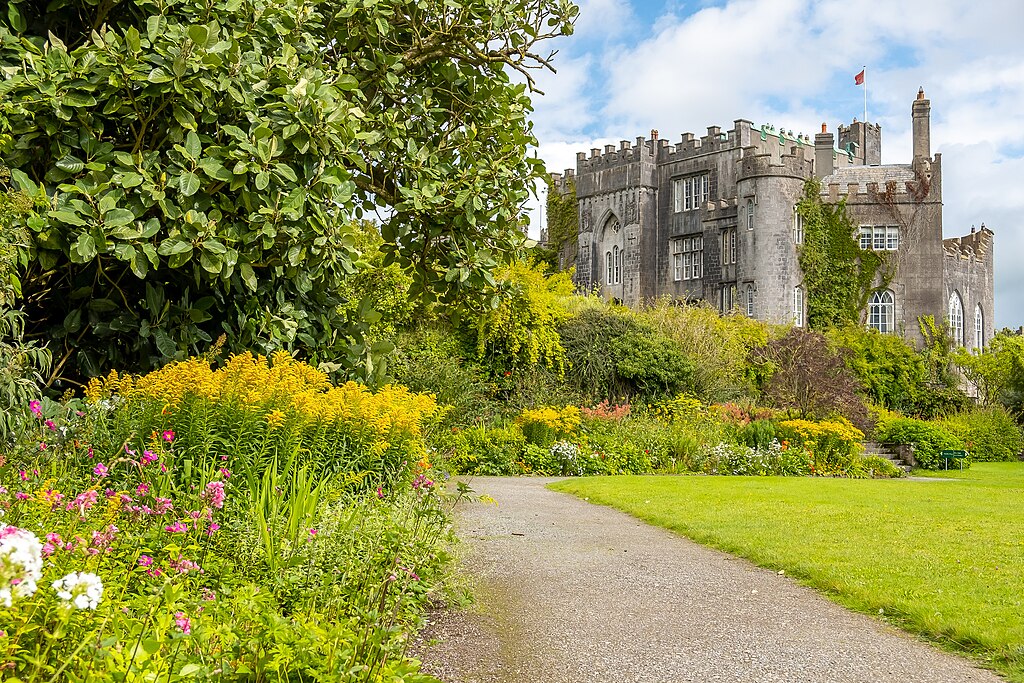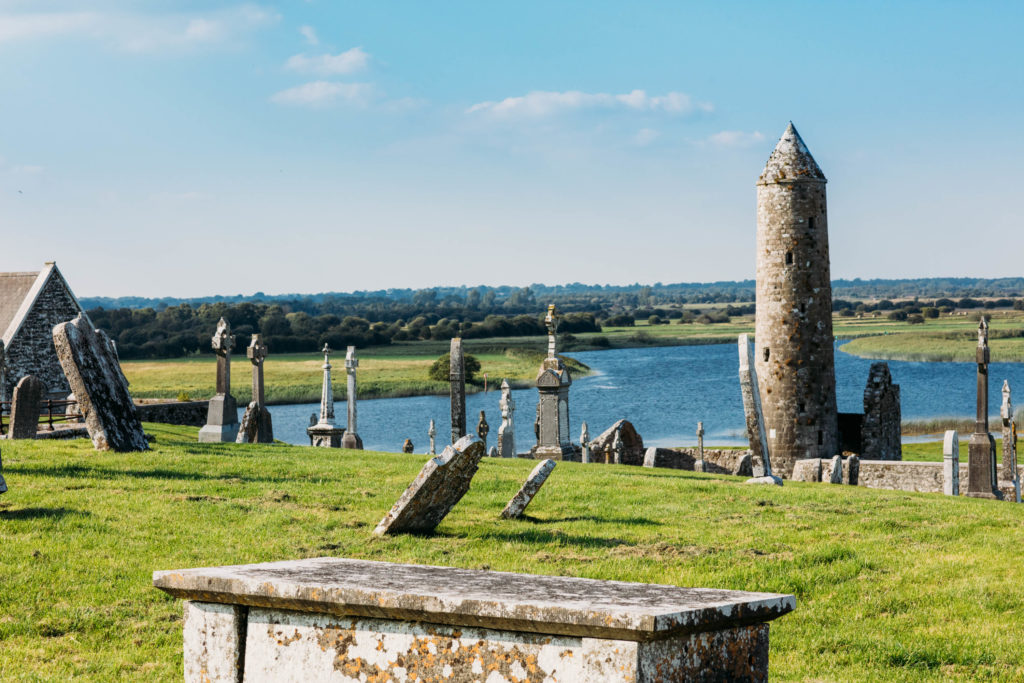EVEN after President Obama discovered that he had family roots in Co. Offaly, this sizable part of Ireland’s Ancient East remained inexplicably overlooked.
Yet Co. Offaly has a landscape that is beautiful, atmospheric, romantic and empty, in some ways probably more redolent of the Ireland of yore than the more traditional destinations of Kerry, west Cork or Clare’s Atlantic coast.
It will undoubtedly, if you’ll excuse me crowbarring song lyrics into this article, steal your heart away.
But there’s a very muscular story too. Here in the stronghold of the O’Carroll clan are more than 400 castles, haunted houses, the sites of bloody battles, Neolithic stones, great wooded valleys that have seen bloody battles, monasteries, pagan wishing wells and bullaun stones with their ancient magical significance.
 An Offaly map from the late 18th century
An Offaly map from the late 18th centuryIt’s also bog central: marshy, squelchy places, but places of delicate beauty — the Bog of Allen, Clara Bog, Boora bog, and Raheenmore Bog are the big movers and shakers. And I use that expression with a rare degree of accuracy.
The place is festooned with quaking bogs, maybe not quite as frightening as they sound, but impressive nonetheless.
The quaking bogs lie in the wetter parts of the bogland, sometimes around the edges of lakes or in valleys in mountain areas. The vegetation, mostly sphagnum moss, forms a floating mat on top of very wet peat or water.
The ability of sphagnum to absorb water is why bogs are so soggy, the very reason they sometimes ‘quake’, or shake underfoot — they’re waterlogged and they’re sitting on water; so quaking seems to be the thing to do. Or so the botanists tell us.
Needless to say those who believe in bog sprites, the ethereal beings who haunt these parts in some number, are held responsible for the quaking business.
Visit Clara Bog Nature Reserve for the Slieve Bloom Mountains in the south of the county for first-hand experience.
But of course Offaly is more than just bogland and fairies.
Ghost-hunting gothic style
THE mostly 18th century Charleville Castle is the largest gothic-style castle in Ireland. A-listers often visited: the castle played host to Lord Byron, who held many parties here during the 19th century. And Lord Byron, once called “that filthy old libertine” knew how to party on down.
I need hardly tell you that the Castle is haunted, severally, by those who met untimely deaths here.
The castle hosts many spooky events, including "fright nights” for ghost fanciers. Charleville has been investigated by many paranormal investigation groups from around the world, and has appeared on Living TV's Most Haunted and Fox's Scariest Places On Earth, as well as, less scarily, Northanger Abbey.
 Then President of the United States, Barack Obama, pictured in the Offaly village of Moneygall, the ancestral home of his great-great-great-grandfather, Falmouth Kearney
Then President of the United States, Barack Obama, pictured in the Offaly village of Moneygall, the ancestral home of his great-great-great-grandfather, Falmouth KearneyFollowing in Barack’s footsteps
OK, until President Obama fetched in Moneygall it was just a sleepy midlands village, and none the worse for that. If you want to follow in Barack’s footsteps, pay a visit to Ollie Hayes's pub where the 44th US President, naturally, enjoyed a pint of Guinness and a spot of traditional music.
A tour round Tullamore
Tullamore, oddly enough, is the scene of the world’s first aviation disaster. In 1785 the town was seriously damaged when a hot air balloon crash resulted in a fire that burned down as many as 130 homes. The local joke goes that the balloon pilot walked around dazed after the accident — but soon perked up when he was told he’d won pipe-smoker of the year award.
Tullamore was part of the first English plantation of Offaly, then given the name King’s County, in the 1570s, and as such has a rich history.
It’s also the venue for Ireland’s largest agricultural shindig, Tullamore Show & FBD National Livestock Show which takes place every August — if weather permits (which It doesn’t always). This year it’s on August 10th.
The event has been called the Glastonbury of Animal Husbandry, and certainly you’ll not be able to stop yourself singing “Tilling me softly with his song” or perhaps, “We had joy we had fun, we had Fresians in the sun.” Sorry, that’s mulch ado about nothing, I know.
Tullamore D.E.W., one of the nation’s top whiskeys, is deeply intertwined with the history of Tullamore, Established in 1829, this triple-distilled, triple-blend whiskey is distilled in a state-of-the-art distillery just outside the town. The Tullamore D.E.W. Visitor Centre offers guided tours and tutored tastings ranging from 50 minutes to five hours in duration. My advice: go for the five-hour binge. Sorry, I mean option.
Just outside Tullamore stands Durrow Abbey, established in the 6th century by St. Columba (Columcille). This was a beacon of early Irish Christianity, playing a vital role in Ireland’s golden age of monasticism artistry. The Book of Durrow, one of the earliest illuminated manuscripts, now housed in Trinity College Dublin, is one of the treasures of that era.
The abbey site features remnants of its storied past, including a high cross, early Christian grave slabs, and a well-preserved holy well. The high cross, adorned with intricate carvings, is enough to make even atheists pause for thought.
 Birr Castle in Co. Offaly
Birr Castle in Co. OffalyCastles and curios
Birr is situated in the middle of the county and indeed is the dead centre of Ireland — as is also Blue Ball just up the road, Glassan in Westmeath and the Cat’s Stone in Mullingar. However, Sir William Petty in his Grand Survey in the 17th century announced that Birr was Umbilicus Hiberniae — so that seems unambiguous enough.
Birr Castle abounds with curios. Its main claim to fame is the huge telescope in the castle grounds. Built in 1845 by Lord Rosse, this huge Heath Robinson contraption was until 1917 the biggest telescope in the world. The outrageous engineering feat truly makes one marvel at the range of human curiosity.
Just up the Camcor River from the telescope, and still within the castle grounds, is Ireland’s oldest suspension bridge. Built around 1820, it’s a pedestrian bridge from which you can appreciate the trees and shrubs lining the river.
If you have even a passing interest in botany it is an essential visit to see one of the greatest displays of magnolia in Ireland, and of course the oldest box hedge in the world — as all you box hedge fanciers out there will already know.
Foraging quests are regularly held, so if you don’t know your shaggy inkcap from your yellow brain fungus contact wildfoodmary.com/ immediately. Mary, I can assure you, will set you right.
Beating Banagher
Anthony Trollope, the writer, reputedly invented your actual post box, and he may have done it here in Co. Offaly. He lived in Banagher, so, send your letters (do they still exist?) from here and you're commemorating a small part of information technology history.
Of his time in Offaly, the English novelist said, in somewhat patronising fashion but complimentary nonetheless: "The Irish people did not murder me, nor did they even break my head. I soon found them to be good-humoured, clever — the working classes very much more intelligent than those of England, economical and hospitable." You’ll probably find much the same yourself in Offaly.
Speaking of literary matters, Charlotte Brontë married the curate in Banagher — he was originally from Co. Antrim.
So just maybe the quiet waters of the Shannon which flow past Banagher is the way to awaken the literary muse within oneself.
Just to complete our linguistic and literary tour of this corner of Offaly, the phrase “Well that beats Banagher (and Banagher beats the devil),” more than likely comes from here, although Derry’s Banagher also lays claim to it. The most commonly proposed explanation is that Banagher was entitled to send two members to Parliament following its charter of incorporation in 1628. These two MPs were usually chosen by the local lord, and not subject to popular vote — so if you could beat that for skullduggery you truly were beating Banagher.
More ghost hunting
If it’s ghosts you want, you’ll scarcely do better than Offaly. Leap Castle, hard by Clareen, has guarded the pass from Slieve Bloom into Munster since the 13th century. Visit this place when a tarpaulin of drizzle blots out the mountains, and the grey granite walls of Leap create a foreboding appearance which fits well with its dark reputation: the most haunted castle in Ireland.
Uninvited guests - of which you can be sure there have been legions - were treated to boiling water, tar, arrows, rocks, and other early weapons of mass destruction, rained down on them from overhead murder-holes. Back then, people tended to be reliably unpleasant. There is no area in the castle which looks as if it was the likely chill-out room.
Leap Castle has always had a reputation as a charnel house. Current owner of Leap Castle, Sean Ryan, has lived here — along with his family — since 1994. He takes the ghouls of Leap Castle in his stride, insisting it isn't all doom, gloom and tomb. "Most of the spirits we see are good-natured," says the Master of Leap, quite matter-of-factly. "We've had no problems - but there's definitely a presence here, no doubt about that. Some visitors find there's actually a physical barrier to entering. Some people have described a stranglehold round their neck."
To placate visitors, Sean can always use music to soothe the savage breast. He’s a former All-Ireland tin whistle champion.
And he’ll certainly give you a conducted tour of the place. If you think you’re hard enough.
 The site of Clonmacnoise monastery in Co. Offaly
The site of Clonmacnoise monastery in Co. OffalyContemplation at Clonmacnoise
The Pilgrim’s Road to Clonmacnoise monastery settlement skirts the northerly edge of Mongan Bog before arriving at the monastery on the banks of the Shannon.
Here at the crossroads of ancient Ireland nearly 1500 years ago, St Ciaran founded a monastery which helped shape Christianity. On a natural gravel ridge overlooking the Shannon sits this magnificent ecclesiastical site. Several high crosses remain, plus assorted churches and gravestones.
Look out especially for the little Nun’s Church, a short walk away from the main buildings. This is home to what is surely the most beautiful doorway in Ireland. The small, one-room church was built by Devorgilla in the 12th century, and the Romanesque western doorway exquisitely frames the bucolic Offaly countryside.
Just to the south stands Clonony Castle, built by the local MacCoghlan clan but subsequently seized by Henry VIII’s people. It eventually ended up in Thomas Boleyn’s possession. Mary and Elizabeth Boleyn lived and died at Clonony, and would doubtless have wandered through the bogland perhaps contemplating the fate of their tragic sister Anne Boleyn, executed by Henry VIII.
The sisters’ tombstone stands some 100 metres from the castle.
The bogs hold many secrets alongside bones, tools, weapons and brooches from across the millennia. Even the odd religious text. But bog butter has to be the strangest: turf cutters have often turned up chunks dating back as far as 5,000 years. Held in wooden containers or vessels, or wrapped in animal skins or bark, they beg the question — why did our ancestors want to bury butter? “Just for fun” hardly seems to be an adequate answer.
Butter was evidently a valuable commodity, possibly used to pay taxes. So the bog may have been a handy ‘fridge’, or perhaps a safe place to hide it from thieves.
On the other hand the butter might have been a votive offering. Or, quite simply, burying butter in the bog might have improved the taste. Or, I suppose, well OK it might have been for fun.
If you do come across some in the bog — best advice is, don’t spread it on your sandwich. Cover it in peat and call the museum.
Take a hike
The Slieve Bloom Way is a 48-mile walking trail which stretches across the eskers, bogland and mountains of Counties Laois and Offaly. En route you’ll pass ruined castles, haunted follies and prehistoric dolmens. The landscape of south Offaly is surprisingly hilly, gloriously coloured and criss-crossed by quiet boreens – ideal for cycling, hiking or horseback riding.
The Slieve Bloom Walking Club www.slievebloom.ie offers guided walks to the mountains. It’s a great way to meet people – you walk the walk and talk the talk with very agreeable people.
In the townland of Glendossaun stands Clear Lake. About 1,000 feet above sea level in the Slieve Bloom Mountains and surrounded by bogland it never goes dry and it never overflows. But legend insists that it’s bottomless. So, mind how you go.
Look for a fine soft day
Boora Bog is a cutaway peat bog in a quiet corner of Offaly. It’s now maintained as a nature reserve by the Irish Wildlife Trust, and is simply enchanting. There are two angling lakes, should you fancy a spot of contemplative fishing.
A prehistoric site was discovered at Lough Boora in the 1970s — there have been Offaly folk appreciating the quiet surroundings here since 6,800 BC.
Where to stay
Kinnitty Castle Hotel, Kinnitty
Rooms from around £140
www.kinnittycastlehotel.com
The Bridge House Hotel, Tullamore
Double rooms from around £95
www.bridgehousehoteltullamore.ie/
The County Arms Hotel, Birr
Currently offering a St Valentine’s Getaway
Two night B&B, prosecco, gourmet dining & more from €275 pps
www.countyarmshotel.com
Tullamore Court Hotel
Double rooms from £95
www.tullamorecourthotel.ie/
For further Ireland travel inspiration click here.

